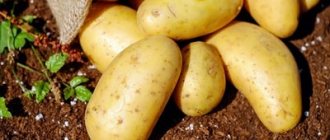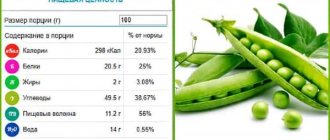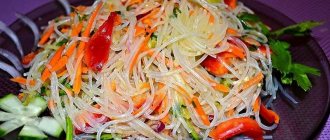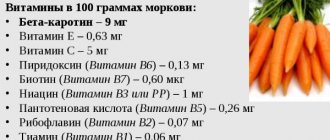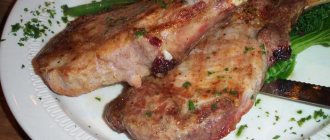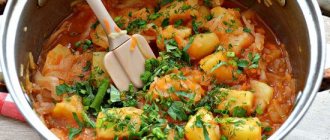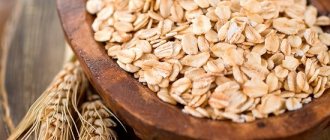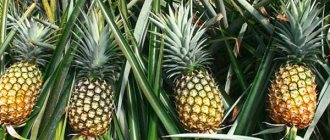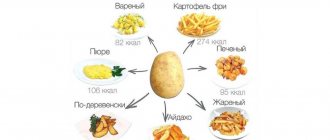Benefits and composition of potatoes
The uniqueness of the culture of the nightshade family lies in the fact that during heat treatment, boiled tubers in their skins are able to retain the nutritional and beneficial properties of a fresh vegetable.
Boiled potatoes contain: nicotinic and ascorbic acids, carotene (provitamin A), betaine, B vitamins (folate, choline, pyridoxine, thiamine, pantothenic acid), vitamins K, E. When cooked, the vegetable contains minerals necessary for the body, such as phosphorus, iodine, sodium, copper, molybdenum, iron, calcium, manganese, selenium and zinc.
The antioxidants contained in tubers resist the formation of tumors, protect against the appearance of cholesterol plaques, and slow down the aging process.
Eating boiled potatoes ensures the most important processes occurring in the human body:
- the presence of potassium has a pronounced diuretic effect;
- Beta keratin maintains vision;
- iodine participates in the activity of the central nervous system, normalizes the endocrine system;
- phosphorus helps in brain function;
- iron supplies oxygen to the body;
- calcium ensures healthy bones and teeth;
- choline, aspartic and glutamic acids, together with methionine, regulate cholesterol levels, the amount and composition of fats;
- potassium has a beneficial effect on heart function;
- magnesium provides a good mood;
- Copper is responsible for the velvety appearance of the skin, and together with vitamin C, it improves and supports immunity.
Eating potatoes is indicated for people with diabetes. Boiled tubers do not irritate the mucous membrane, so they can be included in the diet of patients suffering from stomach ulcers and gastritis.
The vitamin and mineral composition of the vegetable improves muscle function, removes salt and relieves swelling, and slows down aging. Potato microelements ensure control of the body’s functioning and optimize the functioning of all systems.
Chemical composition, microelements and characteristics of jacket potatoes
1. Starch;
2. Choline;
3. Micro- and macroelements: potassium, calcium, iron, magnesium, iodine, manganese, cobalt, copper, molybdenum, selenium, fluorine, zinc, sodium, and phosphorus;
4. Vita A, B1, B2, B5, B6, C, E, K;
5. Niacin;
6. Folic acid;
7. Antioxidants.
All these elements are the reason to call potatoes a healing vegetable. And there are quite a lot of reasons. Let's list some of them.
This vegetable was given the name second bread. He is almost as in demand and has helped people out more than once in times of famine.
Did you know? South Americans prefer black potatoes. The skin of such potatoes has a dark purple tint, close to black, and the flesh is a rich purple color with light veins. In Russia, gourmets appreciate it for its unusual, piquant taste.
Residents of South America prefer black potatoes to the usual white ones.
The chemical composition of potatoes is quite diverse. It is 80% water. Everyone knows and often uses potato starch, obtained from the tubers of the plant, in cooking. 100 grams of raw fruit contains 17.5 g of starch.
Characteristics of BZHU potato tubers:
- Compared to other vegetables, this vegetable contains very little dietary fiber - 1.8 g.
- only 0.1 g of fat per 100 g of raw vegetable.
- one could consider it practically a dietary product, but there are quite a lot of carbohydrates for vegetable crops - 16.6 g.
- protein content is low, 1.9 g. Despite the small amount of protein, potatoes are varied in their composition, although they are not the most vitamin-rich vegetable.
Tubers contain:
- There is almost all vitamin B, quite a lot of vitamin C, as well as E, PP, K, H, A.
- macroelements: calcium, potassium, sulfur, sodium, magnesium, phosphorus, chlorine.
- many different trace elements: iron, iodine, zinc, manganese, chromium, boron, fluorine.
- This plant also contains such rare elements as molybdenum, vanadium, cobalt, rubidium.
With such a varied composition, the calorie content of raw potatoes is low. Of course, if you compare it with other vegetables, for example, cabbage, cucumbers, its energy value is much higher. But in comparison with other products, it can be used as a dietary dish. There are 76 calories per 100 grams of raw vegetables.
Note! The calorie content of cooked potatoes, especially with the addition of vegetable or animal fats, increases sharply - more than 200 kcal in potatoes fried in oil. Considering that one serving contains 150-200 grams, you can swallow 350-400 kcal at a time.
When properly consumed and prepared, potatoes are beneficial for humans.
The nutritional value of raw, baked and fried potatoes is different: during cooking, vita is destroyed and calorie content increases. Cooking a potato dish changes its glycemic index. A high GI value indicates the rapid formation of fat from carbohydrates - such food causes increased appetite and contributes to obesity.
- Raw tubers have a calorie content of 69-70 kcal; BJU content – 10.6%/1.8%/87.7%; glycemic index – 40. This is an excellent dietary and medicinal product, but it does not have high taste qualities.
- Baked potatoes retain the twisted and raw composition of the tubers. However, the starch in it turns into a quickly digestible form, which increases the GI of the dish. Its calorie content is 109-110 kcal; BJU content – 10.9%/8.2%/80.9%; glycemic index – 80. If you are overweight, it is not healthy.
- Boiled potatoes have a low calorie content - 86 kcal (BJU - 8%/1%/85%; GI - 65) - this is the best option for weight loss diets. Preparing puree significantly increases the glycemic index (up to 90 units); the dish is included in diets for gastrointestinal diseases, but it is not suitable for losing excess weight.
- Nutritionists classify fried potatoes as unhealthy foods. Its calorie content is 192 kcal; BZHU – 7%/47%/49%; glycemic index – 60. Such a high-calorie dish, having high taste, forms eating habits that lead to obesity. After all, fried potatoes themselves are not as harmful as an addiction to delicious, rich food.
The composition of any product determines its beneficial properties. The ratio of chemical elements in potatoes depends on its variety. Different species have a certain amount of trace elements and vitamins.
The peculiarity of the root vegetable is that when exposed to ultraviolet radiation, solanine and chlorophyll are formed in it. When cooked, these toxic substances are not destroyed, but when consumed internally, they slowly poison the body.
Most people prefer to eat their potatoes fried, with bacon and fat added. Abuse of this product can cause a heart attack.
Potatoes have a high concentration of vitamin C. One tuber can replenish half the daily requirement of ascorbic acid. It also contains potassium, calcium, iron, magnesium, and many other useful nutrients. The root vegetable satisfies well, and a person does not feel hungry for a long time: 100 g of potatoes contains 164 kcal.
The great benefit of potatoes for the body is that its consumption saturates the body with folic and nicotinic acid, phosphorus, choline and zinc.
The tubers contain alpha-lipoic acid, which has the ability to convert glucose into energy. In addition, this substance is an antioxidant. Scientists say it helps improve vasodilation, control blood sugar levels and protect diabetics from retinopathy.
The peel contains flavonoids and quercetin, which have anti-inflammatory and antioxidant effects. They protect the body from the negative effects of free radicals.
The vegetable contains small amounts of folic acid, phosphorus, choline, zinc, tocopherol, thia and vitaPP. Raw potatoes contain about 12 mg of sodium—less than one percent of your daily requirement for this substance.
Another valuable component is VitaB6, which ensures the normal process of protein synthesis. This vitamin plays a big role in the functioning of the nervous system, brain and cell regeneration. It protects the heart and prevents the development of cancer.
Potatoes contain essential acids: 0.293 g in 100 g of boiled jacket potatoes and 0.324 g in a baked product.
Complex of essential acids:
- Leucine. Boiled - 0.112 g, baked - 0.119 g. Promotes muscle building and fat burning. Participates in the processes of metabolism of fats and carbohydrates. Strengthens the immune system.
- Isoleucine. Boiled - 0.076 g, baked - 0.08 g. The acid serves as the basis for protein and is involved in the process of energy exchange. Promotes rapid recovery of the body after physical activity.
- Valin. Boiled - 0.105 g, baked - 0.125 g. Participates in the formation and maintenance of the immune system of a growing organism. Helps brain function during increased mental stress. Increases the body's endurance and stability in stressful situations.
In addition, tubers contain vitamin A, group B, fiber and organic acids.
100 g of young potatoes contain 20 ml of ascorbic acid. During long-term storage, the amount of vitamin C decreases and by spring it becomes three times less.
Nutritionists believe that potatoes cooked in their skins are healthier. The skin contains microelements valuable for the body.
| Ral composition of jacket potatoes / share of the daily value per 100 g | ||
| Element | Boiled | Baked |
| Calcium | 5 mg/0.5% | 15 mg / 1.5% |
| Iron | 0.3 mg / 3.1% | 1.1 mg / 10.8% |
| Magnesium | 22 mg / 5.5% | 28 mg / 7% |
| Phosphorus | 44 mg / 6.3% | 70 mg / 10% |
| Potassium | 379 mg / 8.1% | 535 mg / 11.4% |
| Sodium | 4 mg / 0.3% | 10 mg / 0.8% |
| Zinc | 0.3 mg / 2.7% | 0.4 mg / 3.3% |
| Copper | 0.2 mg / 20.9% | 0.1 mg / 13.1% |
| Manganese | 0.1 mg / 6% | 0.2 mg / 9.5% |
| Selenium | 0.3 mcg / 0.5% | 0.4 mcg / 0.7% |
| Fluorine | 49.4 mcg / 1.2% | — |
Presence of sugars in potatoes (per 100 g):
- sucrose - 0.18 g;
- fructose - 0.28 g;
- glucose - 0.33 g.
Ripe tubers have a low sugar content - from 0.5% to 1.5%, it varies depending on storage conditions.
There are more than 5 thousand varieties of potatoes in the world. They all differ in composition.
In addition to the varietal, the composition is influenced by:
- storage conditions and duration;
- the climatic conditions in which it was grown;
- fertilizers
How many calories a product contains depends on how it was prepared.
Calorie content of the product in uniform:
- boiled - 87 kcal;
- baked - 93 kcal.
100 g of boiled and baked jacket potatoes contain the same ratio of the daily norm of BZHU:
- proteins - 3%;
- fat - 0%;
- carbohydrates - 7%.
Boiled potatoes in their jackets contain 20.1 g of carbohydrates per 100 g of product. This is about 91% of the total energy from the serving.
Baked in the peel - 21.2 g of carbohydrates, which is 89% of the energy.
| Composition of jacket potatoes | ||
| boiled | baked | |
| Fats | 0.1 g | 0.13 g |
| Squirrels | 1.87 g | 2.5 g |
| Carbohydrates | 20.13 g | 21.15 g |
| Water | 76.98 g | 74.89 g |
| Ash | 0.92 g | 1.33 g |
Boiled and baked jacket potatoes without salt normalize and maintain weight, and participate in cleansing the intestines of toxins.
Why jacket potatoes help you lose extra pounds:
- it is easily absorbed by the body;
- low-calorie;
- starch is broken down into simple sugars, and this does not lead to excess weight gain.
Experts have developed diets where the main product is potatoes, and kefir, cabbage, and eggs are offered as additional products.
What are the benefits of jacket potatoes? When consuming 300 g of potatoes per day, the body is saturated with beneficial substances.
| Vita | Boiled | Baked |
| VitaA | — | 1 mcg |
| Beta carotene | 2 mcg | 6 mcg |
| VitaK | 2.2 mcg | 2 mcg |
| VitaS | 13 mg | 9.6 mg |
| VitaV1 | 0.1 mg | 0.1 mg |
| VitaV3 | 1.4 mg | 1.4 mg |
| VitaV4 | 13.5 mg | 14.8 mg |
| VitaV5 | 0.5 mg | 0.4 mg |
| VitaV6 | 0.3 mg | 0.3 mg |
| VitaV9 | 10 mcg | 28 mcg |
VitaA participates in the rejuvenation of the body through the formation of new cells and slows down the aging process.
The complex of essential acids is involved in metabolic processes. Leucine promotes fat burning.
Vitamin B has a positive effect on many body systems:
- B1 is involved in the functioning of the cardiovascular system, helps the thyroid gland, regulates the activity of the nervous system;
- B4 helps improve memory;
- B5 normalizes metabolism, participates in the production of steroid hormones;
- B6 is responsible for the metabolism of proteins and fats, reduces cholesterol levels;
- B9 is responsible for the growth and development of embryonic tissues during pregnancy and helps the body absorb iron.
Energy and nutritional value of boiled potatoes
The amount of calories that is released from the product during digestion determines the energy value of boiled potatoes. The content of proteins, fats and carbohydrates characterizes the nutritional value of tubers prepared in this way.
It is best to monitor the changes in calorie content (energy value) that occur during the heat treatment of vegetables using examples of popular dishes.
Boiled potatoes in water, peeled and in their skins
There is an opinion that this starchy vegetable is high in calories and therefore not a very healthy product. In fact, such properties of tubers should be considered in conjunction with the cooking method and the composition of the ingredients added to the dish.
The average nutritional value of potatoes depends on its origin, variety and maturity of the fruit, so the final value may differ slightly.
Tubers boiled in water contain the following composition of BZHU (proteins, fats and carbohydrates) per 100 g of product:
Potatoes without peel:
| In uniform:
|
These characteristics may change due to the use of young or mature vegetables.
Boiled potatoes in milk, peeled and in their skins
Tubers boiled in their skins have the lowest energy value. There is an average of 75 kcal per 100 g of product.
Potatoes cooked in milk or in their skins with the addition of such a component have the following BJU composition:
Boiled in milk, g.:
| In uniform with milk, g.:
|
Mashed potatoes with water, milk, and butter
Boiled potatoes, the calorie content of which depends on the ingredients included in the recipe, have different energy values, as can be seen from the presented indicators calculated per 100 g of product.
Puree on water:
| With milk:
| With butter:
|
The nutritional and energy value of cooked food is associated with many indicators, so their value should be determined based on the composition of the finished food.
Calorie content of the product
When planning a diet, it is important to know how many kilocalories are in potatoes. It all depends on the cooking method:
- Boiled potatoes contain 82 kcal.
- In a fried product, the calorie content increases due to the use of oil and reaches 190-200 kcal.
- French fries are even more satisfying. It contains 266 kcal.
It is worth noting the nutritional value of 100 g of potatoes for other cooking methods:
- stewing - 170 kcal;
- puree with butter and milk - 115 kcal;
- in uniforms - 90 kcal;
- chips - 500 kcal.
How many calories and nutritional supplements are contained in 100 g of various dishes with boiled potatoes?
The content of proteins, fats and carbohydrates, as well as the number of calories in boiled tubers, is determined by their maturity, methods of processing vegetables, and the variety of dish components.
The table shows the average BJU indicators of boiled vegetables per 100 g of product:
| Names of dishes | Proteins, g | Fats, g | Carbohydrates, g | Calorie content, kcal |
| Potato soup | 3,27 | 3,09 | 7,17 | 68,54 |
| Potato salad | 1,54 | 0,66 | 13,0 | 89,24 |
| Potatoes with butter | 2,0 | 4,0 | 15,0 | 120,0 |
| Potato cheese | 1,94 | 1,03 | 11,16 | 66,25 |
| With sour cream | 2,0 | 3,0 | 13,0 | 92,0 |
| With mushrooms | 1,84 | 0,37 | 14,28 | 64,28 |
| With stew | 8,00 | 13,00 | 19,00 | 221,00 |
| With minced meat | 2,8 | 7,5 | 15,0 | 137,5 |
The composition and calorie content of cooked tubers also depend on the timing of heat treatment and shelf life of the dish. Most vitamins and microelements remain in freshly prepared food, since the beneficial properties of food are gradually lost during storage.
So are potatoes harmful?
The benefits and harms of potatoes depend on several factors.
- Condition of tubers. Potatoes that have turned green and sprouted are dangerous. Under the influence of sunlight, toxic solanine accumulates in it, causing poisoning:
- destruction of red blood cells, anemia with palpitations, hypotension;
- gastrointestinal upset with nausea, vomiting, diarrhea;
- damage to the nervous system, with symptoms of breath holding, convulsions.
The concentration of poison in the peel and sprouts reaches 65-200 mg per 100 g; there is little poison inside the tuber - 2-4 mg. A content of 20 mg/100 g is safe for humans, and when heated, the toxin content decreases by 80%. So poisoning will occur if you eat several kilograms of poisoned fruits at once, which is unlikely.
- Cooking method. The health benefits and harms of potatoes change when they are cooked.
- The calorie content of a fried dish is 3 times higher than that of a raw product; For overweight people, eating fried potatoes or mashed potatoes is harmful. But the benefits will come from eating boiled potatoes (especially in their skins) without any fat once a day.
- The glycemic index - an indicator of the rate of breakdown of starch - increases during heat treatment. For raw tubers it is 40 units; in baked fruits and purees it rises to 80-90 units. This means that carbohydrates obtained from food are quickly broken down and converted into fat. The habit of eating such foods leads to weight gain.
- Cooking potatoes at temperatures above 120° (chips, fries, potatoes in lard) is harmful - acrylamide is formed - a toxic substance with a negative effect on the nervous system, genes and functions of the genital organs.
- Contraindications. Starch increases blood glucose levels; if you have diabetes, eating a lot of potatoes is harmful. For those treating the heart with beta blockers, eating potatoes can cause hyperkalemia and increase the load on the kidneys.
The benefits and harms of boiled potatoes for people on a diet
In the summer, a large assortment of new potatoes appears on the market, which contain a minimal amount of starch. At the same time, the composition of substances beneficial to the body is maximum.
Potato diets are recognized as one of the effective ways to quickly lose weight.
The opinion that eating potatoes can lead to weight gain is only partly true. Similar consequences arise in case of food abuse. And also an increase in waist size is possible by including fried potatoes in oil in the diet or adding high-calorie sauces to the menu.
For people on a diet, potatoes can have the following positive effects on the body:
- micro- and macroelements in the vegetable (iodine, copper, potassium) will ensure rapid removal of excess liquid;
- vegetable protein will create a feeling of satiety, relieve pangs of hunger and the desire for frequent snacks;
- fiber and dietary fiber normalize the activity of the gastrointestinal tract and remove toxins.
Weight loss occurs successfully if you consume a daily amount of kilocalories that is less than the individual threshold for maintaining body weight. If the standard threshold per day is on average 1,000 kcal, then food intake per day should not exceed 900 kcal. With a significantly higher or, conversely, lower indicator, the weight will only increase.
The calculation of an individual threshold should be entrusted to a nutritionist . The disadvantages of eating boiled potatoes include their high starch content. This substance, under the influence of insulin, is broken down into simple sugars, which, after being converted into glycogen, turn into fat.
In order to correct this situation, it is necessary to combine diet and exercise. During this period, the body may experience a deficiency of vitamins. It is advisable to replenish their composition by additionally including fresh herbs and vitamin complexes in the diet.
Potato harm and contraindications
Young potatoes are no less beneficial. It can be consumed during a diet. It saturates for a long time and replenishes the daily need for vitamins and microelements. Thus, a person receives the energy he needs and controls his appetite.
In early fruits, the amount of starch is insignificant, which determines their benefits. But, unlike old potatoes, the skins of young vegetables contain toxic compounds, which is why you cannot cook them in their skins. When consumed in small portions, the tubers are recommended for diabetics and overweight people.
Vegetable juice from young tubers has a mild laxative, diuretic, immunostimulating, anti-inflammatory and expectorant effect. Drinking juice thickens cell walls and calms the nervous system.
If you compare the contraindications and beneficial properties of potatoes, you can understand that they must be consumed, but in limited quantities.
Numerous studies show that the harm of potatoes is no less than its benefits.
As has already been said, green and sprouted potatoes pose a threat to the respiratory system and circulatory system. When consuming such fruits, muscle spasms, diarrhea and headaches may occur.
It is especially important to know about the dangers of potatoes for people with diabetes. Eating vegetables with a high glycemic index can cause a spike in blood sugar. But if you eat potatoes with other foods that have a low glycemic index, you can avoid an increase in sugar. Starch can trigger gestational diabetes.
Scientists have found that when root vegetables are stored in the refrigerator, starch is hydrolyzed to sugars.
People with painful joints should refrain from eating potatoes due to the possible worsening of the condition and progression of the disease.
Fried potatoes pose the greatest harm to the body. At temperatures above 120 C, it produces acrylamide, which is found in plastics, cigarette smoke, glue and dyes. This substance can provoke the development of cancer processes. It also negatively affects reproductive function.
The highest concentration of acrylamide is in potatoes fried with lard, chips and french fries.
Potatoes are also harmful if consumed in excess. The potassium it contains can accumulate in the body and cause kidney failure. Damaged kidneys cannot excrete potassium, which can be fatal.
Fried potatoes pose the greatest danger to pregnant women and their unborn babies.
- Boiled potatoes are a low-calorie dish, containing only 87 calories per 100 grams. When used correctly, it helps to lose excess weight. Just don't add oil or high-calorie ingredients to it. It's best to season with herbs or healthy spices for flavor.
- 300 grams of potatoes contains approximately 0.3 grams of fat and 5.6 grams of protein. Despite the low fat content, the dish gives satiety, so the feeling of hunger will not appear soon.
- Boiled potatoes provide the body with micronutrients as they are rich in elements such as potassium, magnesium and phosphorus. If you cook potatoes peeled, they will lose some of their rali, so it is better to cook them with the skins on and then peel them.
- Boiled potatoes are rich in vitamin B6, niacin, thiam and vitamin C. Contains about 25-30% of the daily vitamin C intake and provides almost half of the daily vitamin B intake
- Both peeled and peeled potatoes contain a large amount of dietary fiber. Their main task is to maintain the cleanliness of the digestive system so that health problems do not arise, reducing the likelihood of developing colon cancer. Undigested food remains carry food rals into the body and help cleanse the digestive tract.
- Studies have shown that potatoes also help lower blood pressure.
- Potatoes also act as an antioxidant as they contain high amounts of vitamin C. It removes toxins from the body and cleanses the digestive tract. Also helps maintain natural levels of gut bacteria.
- Potatoes help strengthen the immune system and also fight inflammation in the body.
- Research has shown that vitamin B6, found in potatoes, helps improve brain function and combat mood disorders by promoting the production of neurotransmitters such as serotonin, dopa, and others.
Boiled potatoes and mashed potatoes are harmful for people with diabetes and those who are prone to obesity due to their high glycemic index. After eating these dishes, blood sugar quickly rises and, if the body has not processed all the energy, glucose can be converted into fat. It is also not recommended to eat potatoes for people with high stomach acidity and flatulence. Contraindicated only in case of individual intolerance to the ingredients.
You should not eat green tubers. They contain the poison solanine, which can cause severe poisoning.
Considering the rich composition of vitamins and various beneficial substances, the benefits of potatoes are obvious. However, beneficial substances are contained only in the tubers; the above-ground part of the plant is poisonous. Potato peels can bring not only great benefits to the body, but in some cases, harm.
The healthiest varieties are those with red and purple skin. Also, a lot depends on the shelf life of the tubers; the younger the fruits, the more vitality they contain. Potatoes from the summer harvest or autumn ones that have just been dug up are most useful.
Much depends on how you prepared the vegetable. Of course, there will be no benefit from potatoes fried in oil, only harm. It is almost never eaten raw, but is wonderfully used for external use. Potatoes can help normalize well-being and improve the health of women, men and even children.
Men are more likely than women to suffer from cardiovascular diseases and surges in blood pressure. Eating baked potatoes and young tubers in their jackets can lower blood pressure, normalize heart function, and reduce the risk of heart attack.
Potato starch is used not only in baking, but also in cosmetology
Starch, which is abundant in tubers, helps lower cholesterol and reduce the risk of vascular atherosclerosis. Often men do not watch their diet; they eat a lot of spicy and fatty foods, which leads to gastritis and ulcers. Your favorite root vegetable can also help, as it reduces acidity and promotes tissue regeneration. This property of the vegetable is very useful for women.
Potatoes often help women for cosmetic purposes when they are used raw for masks. Potatoes have a positive effect on the general condition of the body, increase tone, and calm the nervous system. Helps with kidney function, thanks to potassium it removes excess water from the body, which helps reduce swelling.
Kids' favorite side dish is mashed potatoes.
This vegetable also benefits children. It’s not for nothing that children are introduced to purees in their diet at a young age. Potatoes are a completely non-allergenic product, but they are tasty and nutritious. From our grandmothers we know about the healing properties of potato inhalations for colds. Who among us has not breathed over boiled potatoes?
Even young mothers are recommended to eat this vegetable.
Women expecting a baby often suffer from nausea and heartburn. In this case, raw potatoes can be beneficial. Drinking juice from tubers will relieve attacks of heartburn and will not harm the unborn baby, nor will it affect your figure - one serving of potato juice (200 g) contains 158 calories.
It is better to avoid fatty foods during pregnancy
Young mothers are forced to limit their diet while breastfeeding. Since many foods can cause allergies, the baby may have an upset stomach. But this does not apply to potatoes. This is an absolutely hypoallergenic product, and you can eat it without fear of harming your child. But remember that it is better to eat boiled or oven-baked potatoes, no fries or potato chips in your diet - these are very high-calorie dishes.
Due to its properties, raw potatoes are often used in dietetics.
In dietetics
Previously, nutritionists categorically forbade those trying to lose weight from eating potato dishes. The situation has changed, and now this vegetable is included in many dietary dishes.
Young boiled potatoes are tasty and healthy
Thanks to fiber, it perfectly cleanses the body. The calorie content of dishes will be low if the fruits are boiled, steamed or baked in the oven with spices. Exceptions are fried in a large amount of oil, French fries, baked vegetables with meat and mayonnaise, etc.
But the beneficial effect of raw potatoes on the human body, especially on skin health, has always been undeniable.
In cosmetology
Potatoes have a wonderful effect on human skin. It has such healing qualities as:
- anti-inflammatory;
- regenerating;
- softening;
- tonic;
- nutritious.
In cosmetology, raw and boiled tubers and freshly squeezed juice are used. Masks are made both on the face and on different parts of the body - the skin of the hands, feet, and décolleté. Such products can nourish dry, irritated skin, reduce wrinkles, and relieve puffiness.
Potato mask with rejuvenating effect
How to cook potatoes correctly
Boiled potatoes (the calorie content of the dish can be adjusted by the composition of the ingredients) is prepared easily and quickly. However, to obtain tasty and healthy food, you should always take into account the nuances of heat treatment of potatoes, as well as the advice of experienced chefs.
For example:
- You need to cook vegetables in an enamel pan: this coating prevents the oxidation process. The lid should be tight-fitting and opaque, as light provokes the decomposition of vitamins;
- We must not forget that potatoes contain water-soluble nutritional components, so in order not to lose healthy juices, proteins and vitamins, you should fill the tubers with a small amount of water;
- To prepare jacket potatoes, the product must be washed thoroughly. If the tubers are boiled in their skins, they must be removed with a sharp knife, cutting off a layer of up to 2 mm. Don’t forget to destroy all the eyes;
- It is undesirable to keep peeled tubers in cold liquid for a long time - the product will lose its individual taste;
- New potatoes require slightly different handling. The thin skin can be removed very easily using the “old-fashioned” technique. Put on kitchen rubber gloves. Pour coarse salt into a bag and place small tubers. Rub them with the salty mixture, then alternately place them in a bowl of hot and cold water for a few seconds;
- For boiling, peeled fruits must be placed in boiling filtered water. If you pour cold liquid over the vegetables, the top layer will be ready the fastest, while the inside of the fruit will remain raw. Reduce heat treatment time by 5 minutes. A piece of butter thrown into the water will help;
- to prevent the peel from bursting on the tubers during cooking, they need to be pricked with a fork;
- the potatoes will not boil if you drain a little hot water and add cold liquid;
- tubers, divided into parts, will remain white when vinegar (6%) is added at the rate of 1 tbsp. l. for 1 liter of water;
- Cooking time depends on the crop variety and fruit size. To obtain a crumbly dish, cook the tubers for 15 minutes. from the moment it begins to boil over low heat in a tightly closed container.
When all the subtleties and culinary nuances of obtaining tasty and healthy boiled potatoes are known, you can test the acquired knowledge in practice.
To prepare the dish you will need:
- butter - 20 g;
- potatoes - 500 g;
- salt - ½ tsp;
- drinking water - 300 ml;
- dill.
Cooking method:
- Peel the tubers, rinse, cut into quarters.
It is important to peel boiled potatoes well. - Heat filtered water to a boil, add salt, and add the separated tubers.
- Throw in a piece of butter, after the start of a new boil, reduce the height of the flame, close the container.
- Cook the product until soft, then drain the liquid.
- Leave the dish with the finished potatoes over medium heat so that any remaining moisture evaporates and the tubers dry well.
Serve the dish hot. Scatter pieces of fresh butter over it, sprinkle generously with chopped dill.
Chemical composition, microelements and characteristics of jacket potatoes
Stages of preparing boiled jacket potatoes:
- pour enough water into the pan so that after immersion the potatoes disappear, but do not sink deeply;
- add salt to cold water;
- choose tubers of the same size;
- lower the vegetables after the water boils;
- The readiness of potatoes is determined by the cracked skin.
Steps for preparing baked jacket potatoes:
- take tubers of the same size, wash, coat with vegetable oil and salt;
- make punctures in 2-3 places with a fork so that the peel does not burst;
- cover a baking sheet with parchment paper and lay out the tubers so that they do not touch;
- preheat the oven to 180°C and bake 30-35 t;
- Check readiness with a knife or fork.
The golden crust is formed thanks to the oil.
It is recommended to peel green tubers in a thick layer to reduce the risk of harmful elements entering the body. It is strictly prohibited to boil such potatoes in their skins.
Potatoes have no specific contraindications. Allergy to this product is extremely rare.
It is recommended to discuss the consumption of potatoes with your doctor if you have diabetes.
The main benefit of potatoes is that, as a balanced food product, it provides many of the body's needs.
- Starch (up to 17.5% in tubers) is an excellent source of energy for an active lifestyle and intense mental work. It reduces cholesterol in the blood and prevents vascular sclerosis.
- Potato protein (1.2-2%) is similar in composition to animal protein, contains important acids, and can partly compensate for the lack of animal food.
- Tubers contain 70-80% water. Contrary to popular belief, potatoes themselves are a low-calorie product (73-77 kcal/100 g), contain only 0.4% fat, and people who want to lose weight do not have to give them up.
The composition of rahl in tubers will dispel doubts about whether potatoes are useful for diseases.
Advertisements
Innovative shovel “Harvest”
- Potassium is the highest in potatoes (19% of the daily requirement per 100 g). The macroelement is necessary for the functioning of the heart, regulates blood pressure, quickly removes water, relieves swelling, and reduces acidity. Potatoes are necessary for people suffering from hypertension, heart and kidney failure, gastritis and its complications.
- Rare microelements: nickel, chromium, zinc, molybdenum – stabilize the body’s hormonal levels and immune system.
- For those with allergies, potatoes become an indispensable dietary product, because they practically do not cause a rejection reaction.
The benefits of potatoes are obvious. But many today refuse to use it for fear of harming their health.
After heat treatment, the benefits of eating potatoes decrease, but they retain many valuable properties. People who understand how potatoes are useful and when they are harmful, try to consume them in accordance with their age and storage time.
- Young potatoes bring the greatest benefit, so you should eat more of them in the summer.
- It contains a lot of not only ascorbic acid, but also vitamins of group B. VitaB6 is necessary for normal metabolism, protein synthesis, brain activity, hormone production, and toxin removal are associated with it. Lack of vitamin B6 sharply reduces immunity and vitality. 100g of young potatoes contains 18% of the body's daily requirement. To preserve the vitality, it is best to cook or bake it in the peel.
- Each young tuber contains up to 3 g of dietary fiber. Boiled young potatoes will not harm people suffering from stomach diseases, since their fiber does not irritate the mucous membrane at all.
- There is less starch in young tubers, and its calorie content is 10-30% lower than that of mature fruits. Diets for weight loss are optimal with young fruits, if they are boiled in their skins and consumed without salt.
Other beneficial properties are preserved in ripe potatoes until spring:
- As potatoes age, the starch content in them increases, and the energy value of all potato dishes increases.
- When treating burns, the starch in raw and boiled potatoes relieves pain and protects the wound from the formation of blisters, but doctors do not recommend using traditional methods for serious skin lesions.
Information about the benefits and harms of potatoes will help you appreciate this root vegetable. A properly cooked vegetable undoubtedly brings great benefits. Baked potatoes without fat provide us with fiber, which protects against cancer and heart diseases.
You can also cook potatoes in their jackets. This dish retains all the beneficial properties of the vegetable. Magnesium, phosphorus and calcium provide bone compaction. The root vegetable contains a lot of potassium, which effectively removes salts and excess fluid from the body.
Phosphorus, iron and zinc activate the production of collagen, which makes the skin elastic and toned and strengthens the musculoskeletal system.
People with hypertension can improve their condition with regular, dosed consumption of the vegetable. One of the beneficial properties of potatoes is their vasodilating effect.
Potatoes help with headaches, dizziness, fatigue, stimulate the functioning of brain neurons, thereby improving memory, mental activity and concentration.
People who have a lot of physical activity need to consume the root vegetable to increase energy and eliminate fatigue. Great benefits of potatoes for problems with the digestive system. It lubricates the walls of the esophagus and stomach, eliminates stagnation and bloating, and normalizes stool.
1. Strengthens blood vessels;
2. Recommended for use for gastrointestinal diseases (gastritis, colitis, ulcers);
3. For bad cholesterol;
4. For kidney problems;
5. A good remedy for diseases of the genitourinary system;
6. Useful for arthritis and arthrosis;
7. Boiled vegetables are an excellent remedy for ARVI (inhalation);
8. Applied to the chest, in the form of a compress, treats bronchitis.
The best healing effect is from fresh, young tubers. There is also a lot of information about the fact that potatoes are incredibly healthy in their raw form, but this is a separate topic.
Boiled potatoes can be harmful to the body due to their high starch content. But it is not recommended for flatulence and urolithiasis. Solanine accumulates in green or old potato skins, which can cause poisoning. Unpleasant symptoms such as dizziness, vomiting, and diarrhea may appear.
A few potatoes a day and you will not only enjoy this food, but also benefit your entire body. Whether it’s a separate dish, a salad or a soup, it’s always nutritious and healthy.
And to preserve all the vitamins, you need to follow some rules when preparing potatoes. It is necessary to use enamel cookware directly when cooking vegetables. And put the tubers in boiling water. Using potatoes with other vegetables will increase their benefits for the body.
Contraindications to eating boiled potatoes
Potatoes do not always have a beneficial effect on the body.
Contraindications to taking a boiled product may be its high calorie content, as well as the person’s health status:
- It is unacceptable to use vegetables with greenish skin. Chlorovyl tubers give this color. This substance will not cause any harm, but the hemolytic poison corned beef (a compound of glucose and sonanidine) contained in the tubers can cause severe poisoning, including death. A similar result can come from using sprouted tubers with so-called eyes. Such vegetables pose a particular danger to pregnant women - they may have a teratogenic (causing malformations) effect on the fetus;
- Fruits grown in soil with nitrates will be harmful to health. The content of nitric acid salts in the product exceeding the norm threatens respiratory failure, food poisoning, and the risk of malignant neoplasms;
- Eating potatoes is contraindicated for people with known metabolic disorders and diabetes. This recommendation is due to the high content of easily digestible carbohydrate elements;
- The inclusion of boiled tubers in the diet is excluded if there is an individual intolerance to the product. Ignoring such an installation can provoke allergic reactions in the form of itching, skin rashes, Quincke's edema;
- It is undesirable to consume vegetables for patients suffering from obesity, acute urolithiasis, enterocolitis, eneritis, and flatulence.
Potatoes are not recommended for people with increased sexual arousal or the presence of sexually transmitted diseases.
Delicious and simple recipes with boiled potatoes
Proper nutrition is not only about using healthy foods, but also about combining them correctly. Boiled tubers, which have a high GI (glycemic index), are digested almost instantly, increasing blood sugar levels. To reduce such consequences, the dish should be consumed with a variety of salads from fresh vegetables, seasoned with yogurt or kefir.
Potatoes with zucchini
Ingredients:
- butter - 100 g;
- whole milk - 400 ml;
- potatoes - 20 pcs.;
- young zucchini - 2 pcs.;
- table salt - to taste.
Cooking method:
- Remove the skins from the potatoes, rinse, and divide into quarters.
- Place the tubers in an enamel pan, pour boiling water, season the liquid with salt. Cook until soft.
- Cut the zucchini into small pieces, place in the mixing bowl, and distribute evenly throughout the container.
- Turn on the “Steam” mode, cook the vegetables for 20 minutes, then process with a blender until pureed.
- Drain the water from the finished potatoes, add hot milk, add the squash mixture;
- Mix everything well with the butter.
Serve this dish for breakfast, lunch or dinner with a fresh salad.
Mashed potatoes with egg and onion
Boiled potatoes (the calorie content of food depends on the type of tubers) goes well with eggs and onions. To obtain a fluffy puree, you must use a mature vegetable with a high starch content.
Grocery list:
- butter - 80 g;
- whole milk - 400 ml;
- eggs - 2 pcs.;
- potatoes - 2 kg;
- onion - 150 g;
- salt - according to preference.
Preparation procedure:
- Peel the potatoes, divide into quarters, and place in a saucepan.
- Place onion, chopped into thin half rings, on top of the tuber pieces.
- Pour boiling water over the vegetables so that the amount of liquid is 2.5 cm above the tubers.
- Pour salt into a container and cook for 25 minutes. Once boiling begins, reduce heat to medium.
- Strain the broth, mash the potatoes until pureed, periodically adding portions of hot milk.
- Add eggs and butter to the resulting mass, beat the mixture with a blender.
Serve the puree as a side dish or on its own.
Potato cheese
It is not difficult to prepare such a product at home. It’s worth doing this once, and the delicious dish will be included in the permanent menu of the family diet.
List of components:
- domestic eggs - 2 pcs.;
- potatoes - 1 kg;
- sour milk (whole and full fat) - ½ l;
- salt, hot pepper.
Cooking order:
- Peel the potatoes, cut into cubes, boil until soft in slightly salted water.
- Drain the liquid and mash the tubers so that there are no lumps left.
- Cool the puree a little, then pour in sour milk, add exclusively fresh eggs. Please note that the recipe does not involve heat treatment of products. For this reason, it is advisable to use domestic eggs, which will not only have high quality, but also yolks with rich color.
- Stir the potato mixture, season with salt and pepper, and place on a clean cotton cloth. Collect it in a “bag”, place it in a colander/sieve, and place pressure on top.
- Place the assembled “structure” in a spacious bowl to drain all the liquid released from the workpiece.
Remove the cloth, let the cheese dry a little, and serve.
Potato soup
Grocery list:
- butter - 30 g;
- egg - 1 pc.;
- drinking water - 2 l;
- potatoes - 4 pcs.;
- minced meat - 300 g;
- carrots, onions - 1 pc.;
- garlic powder - 1 tbsp. l.;
- salt, pepper, herbs - to taste;
- turmeric - ¾ tsp;
- laurel leaf.
Step-by-step preparation:
- Peel the tubers, rinse, cut into strips or in any other form.
- Boil filtered water in a saucepan, add potatoes, add salt, and boil the product until soft.
- Remove the skins from the onion, chop finely, and fry until golden brown. At the end of the process, add peeled, coarsely grated carrots.
- Turn off the heat, add granulated garlic or cloves passed through a press.
- Add the onion mixture to the prepared minced meat and mix thoroughly.
- When the potatoes are ready, add the meat mixture and cook for another 5 minutes.
- Place the egg into the bowl, beat with a fork together with the turmeric, and pour the mixture into the container with the future soup. Throw in the bay leaf after 3 minutes. finish cooking.
Pour chopped herbs (parsley or dill) into the soup and leave the dish for a quarter of an hour.
Dutch potatoes
Boiled potatoes (the calorie content of the dish can be adjusted by the amount or composition of added fat) is one of the favorite national dishes in this country, because it is no coincidence that varieties of tubers of the same name occupy leading positions among other types of crops.
Required components:
- butter - 6 tbsp. l.;
- broth - 2 l;
- potatoes - 3 kg;
- lemon juice - 4 tbsp. l.;
- salt, black pepper, herbs - to taste.
Cooking technology:
- You can use chicken or other meat to get a flavorful broth.
- Peel the potatoes, rinse, and divide into halves or quarters.
- When the broth is ready, dip the processed tubers into it and cook over low heat, covered, until the fruits are soft.
- Place the finished potatoes in a deep bowl, pour in the broth in which the product was cooked.
- Melt fresh butter, add pepper, salt, lemon juice, finely chopped herbs.
Place the fragrant gravy in a bowl with potatoes and serve the appetizing dish to the table.
German potato salad
Product composition:
- mayonnaise - 200 g;
- onion - 4 pcs.;
- pickled cucumbers - 5 pcs.;
- potatoes - 1.6 kg;
- bouillon cube - 1 pc.;
- boiled eggs - 6 pcs.;
- mustard - 1 tsp;
- pepper, salt - according to preference.
Step-by-step preparation:
- Boil the peeled potatoes in slightly salted water. Drain the liquid and dry the halved tubers over medium heat.
- Remove the shells from the eggs and chop into large pieces.
- Peel the onions, arrange into rings, then blanch. To do this, the vegetable should be left for 20 seconds. Place in boiling water, then in cold water. This technique will not spoil the crispy properties of the onion, but will make it less hot.
- Dilute the bouillon cube with boiling water according to instructions. Add mustard, beat the mixture with a blender until smooth.
- Place the ingredients in the salad bowl in the following order: hot potatoes cut into slices, blanched onions, pieces of eggs, sliced pickles, mayonnaise.
- Add ground pepper and salt, pour mustard broth over the mixture, and gently mix the mixture.
Cool the resulting German salad, covered, at room temperature. Serve the dish with delicious sausages.
Potatoes in milk
An old recipe for a simple but very healthy and tasty dish.
List of components:
- sunflower oil;
- bulbs - 2 pcs.;
- whole milk - 700 ml;
- potatoes - 700 g;
- premium flour - 1 tbsp. l.
Cooking method:
- Peel the tubers, divide into small pieces, and pour boiling water over them. Salt the mixture, cook until half cooked, then drain in a colander.
- Boil whole milk and add the processed tubers to it. Cook the products for up to 15 minutes, constantly stirring the composition.
- Fry the flour in a dry frying pan, pour it into the bowl with the potatoes.
- Remove the skins from the onion, chop it into half rings and sauté in oil until translucent.
Place the prepared tubers on deep serving plates and place delicious onion rings on top. Deliciously cooked potatoes are useful for both adults and children. Boiled tubers retain a high calorie content and a huge range of nutrients, especially necessary for a growing child's body.
Article design: Anna Vinnitskaya
Use in folk medicine and cosmetology
Potatoes have found application not only in cooking.
Flowers and tubers are used in folk medicine and cosmetology. They are used as part of medicinal masks, lotions, decoctions, compresses, suppositories, and lotions.
In folk medicine
Remedy for treating tonsillitis:
- boil dried potato flowers in the following proportion: 1 tbsp. l. raw materials for 1 glass of water;
- cool;
- Gargle with the decoction 3 times a day for 10 days.
Burn remedy:
- raw potatoes are grated on a coarse grater;
- wrapped in 2-3 layers of gauze;
- a compress is applied to the burn site.
Inhalation for colds:
- boil potatoes in their jackets;
- breathe 5-10 tons of steam before bed.
In cosmetology
Potato mask “Freshness”:
- boiled hot potatoes are crushed, a raw egg and 2 tbsp are added. l. milk;
- mix the ingredients and apply the cooled mass to the face;
- hold a mask 15-20 t;
- wash off with warm water;
- do a contrast rinse with cold and warm water.
The face becomes fresh and takes on a radiant appearance.
Hand mask “French”:
- boil two tubers and make a puree;
- add 10-12 drops of glycerin, 5-6 drops of lemon juice;
- Apply the mixture to your hands and hold 10 t.
Recommended for chapped and red hands from frost.
Lotion for problem skin “Stop acne”:
- grate one potato and squeeze out the juice;
- prepare chamomile decoction - 2 tbsp. l. chamomile flowers are poured with 1 glass of boiling water and infused 30 t;
- mix potato juice and strained cold broth;
- wipe the face with the prepared lotion using a cotton swab.
The unique chemical composition has made the root vegetable in demand among traditional healers.
- Potatoes have a healing effect. It is enough to attach a slice of raw vegetable or apply a compress of juice to the wound and after a while it will heal.
- Potatoes are good for burns.
- It is also used to cleanse the intestines.
- Fresh juices with the addition of carrots and celery normalize the functioning of the digestive system.
- Ladies use potato masks to whiten their faces and eliminate fine wrinkles.
